函数的递归调用
介绍:一个函数在函数体内又调用了本身,称之为递归调用
例子:
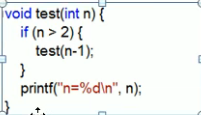
①当在函数main内调用test(4)时,执行判断if,由于4>2,执行test(n-1),此时n=4,则传值为test(3)
②继续执行判断if,由于3>2,执行test(n-1),此时n=3,则传值为test(2)
③继续执行判断if,由于2>2不成立,不执行test(n-1),此时n=2,输出n=2,栈③销毁
执行完③后,要返回上一个栈②,执行printf,输出n=3,栈②销毁
执行完②后,再返回上一个栈①,执行printf,输出n=4,栈①销毁
最后返回给main
打印为:
内存图如下:
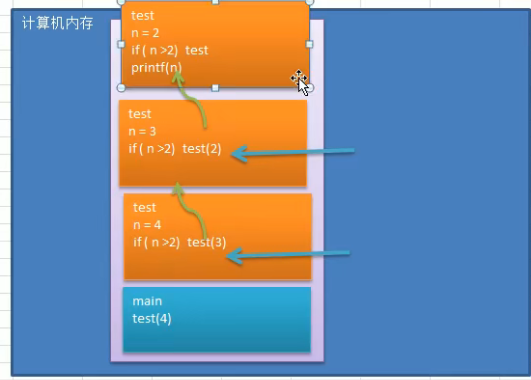
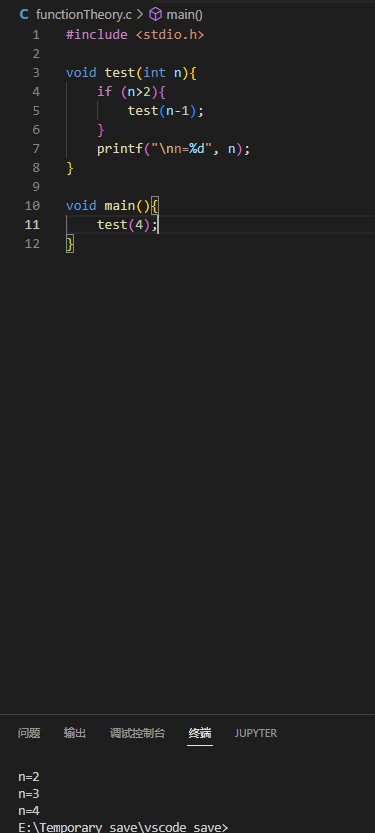
1 #include <stdio.h> 2 3 void test(int n){ 4 if (n>2){ 5 test(n-1); 6 } 7 printf("\nn=%d", n); 8 } 9 10 void main(){ 11 test(4); 12 }
对于过程,记住先进后出
例2: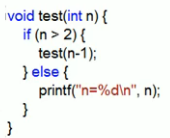
同样是函数main内调用test(4)
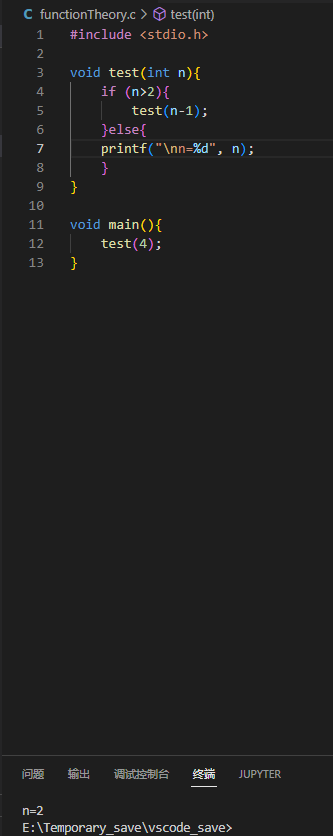
1 #include <stdio.h> 2 3 void test(int n){ 4 if (n>2){ 5 test(n-1); 6 }else{ 7 printf("\nn=%d", n); 8 } 9 } 10 11 void main(){ 12 test(4); 13 }
注意函数条件的设置,防止出现无限递归导致栈溢出
如果执行到return语句,会直接返回到函数调用的位置继续执行,而函数内return语句后面的不再执行

实例:
1.要求输入一个n,打印出斐波那契数列的第n位数字
1 #include <stdio.h> 2 3 int test(int res){ 4 if(res == 1 | res == 2){ 5 return 1; 6 }else{ 7 return test(res-1) + test(res-2); 8 } 9 } 10 //分析:如果n=1或者n=2,返回1,从n=3开始,返回前两个值相加 11 void main(){ 12 int n = test(7); 13 printf("%d",n); 14 }
2.已知f(1)=3,f(n)=2*f(n-1)+1,求f(n)
1 #include <stdio.h> 2 3 int test(int res){ 4 if(res == 1){ 5 return 3; 6 }else{ 7 return 2*test(res-1)+1; 8 } 9 } 10 11 void main(){ 12 int n = test(5); 13 printf("%d",n); 14 }
3.
1 #include <stdio.h> 2 3 //分析 4 //day=10,有1个桃 5 //day=9,有4个桃,(day10+1)*2=4 6 //day=8,有10个桃,(day9+1)*2=10 7 int m(int day){ 8 if(day == 10){ 9 return 1; 10 }else{ 11 return (m(day+1)+1)*2; 12 } 13 } 14 15 void main(){ 16 int x = m(1); 17 printf("%d",x); 18 }






【推荐】国内首个AI IDE,深度理解中文开发场景,立即下载体验Trae
【推荐】编程新体验,更懂你的AI,立即体验豆包MarsCode编程助手
【推荐】抖音旗下AI助手豆包,你的智能百科全书,全免费不限次数
【推荐】轻量又高性能的 SSH 工具 IShell:AI 加持,快人一步
· winform 绘制太阳,地球,月球 运作规律
· AI与.NET技术实操系列(五):向量存储与相似性搜索在 .NET 中的实现
· 超详细:普通电脑也行Windows部署deepseek R1训练数据并当服务器共享给他人
· 【硬核科普】Trae如何「偷看」你的代码?零基础破解AI编程运行原理
· 上周热点回顾(3.3-3.9)